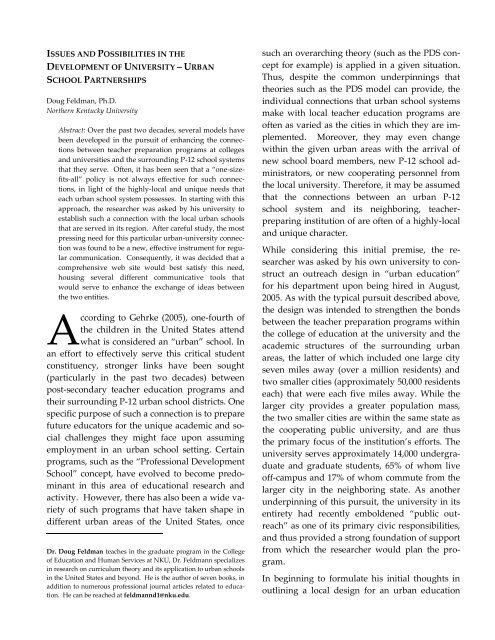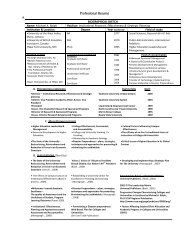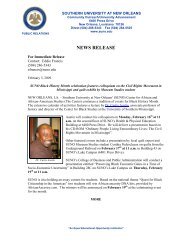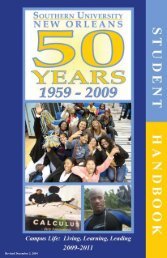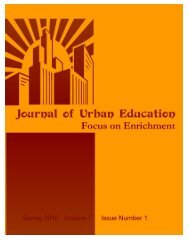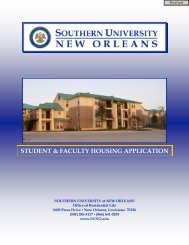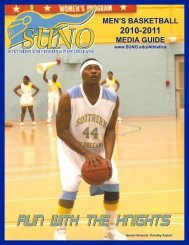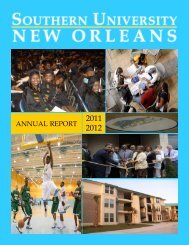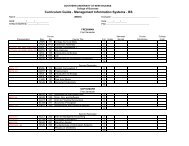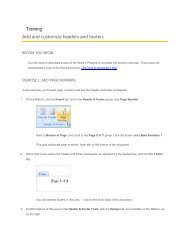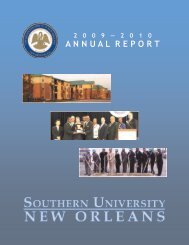Journal of - Southern University New Orleans
Journal of - Southern University New Orleans
Journal of - Southern University New Orleans
- No tags were found...
Create successful ePaper yourself
Turn your PDF publications into a flip-book with our unique Google optimized e-Paper software.
ISSUES AND POSSIBILITIES IN THEDEVELOPMENT OF UNIVERSITY – URBANSCHOOL PARTNERSHIPSDoug Feldman, Ph.D. 18Northern Kentucky <strong>University</strong>Abstract: Over the past two decades, several models havebeen developed in the pursuit <strong>of</strong> enhancing the connectionsbetween teacher preparation programs at collegesand universities and the surrounding P-12 school systemsthat they serve. Often, it has been seen that a ‚one-sizefits-all‛policy is not always effective for such connections,in light <strong>of</strong> the highly-local and unique needs thateach urban school system possesses. In starting with thisapproach, the researcher was asked by his university toestablish such a connection with the local urban schoolsthat are served in its region. After careful study, the mostpressing need for this particular urban-university connectionwas found to be a new, effective instrument for regularcommunication. Consequently, it was decided that acomprehensive web site would best satisfy this need,housing several different communicative tools thatwould serve to enhance the exchange <strong>of</strong> ideas betweenthe two entities.According to Gehrke (2005), one-fourth <strong>of</strong>the children in the United States attendwhat is considered an ‚urban‛ school. Inan effort to effectively serve this critical studentconstituency, stronger links have been sought(particularly in the past two decades) betweenpost-secondary teacher education programs andtheir surrounding P-12 urban school districts. Onespecific purpose <strong>of</strong> such a connection is to preparefuture educators for the unique academic and socialchallenges they might face upon assumingemployment in an urban school setting. Certainprograms, such as the ‚Pr<strong>of</strong>essional DevelopmentSchool‛ concept, have evolved to become predominantin this area <strong>of</strong> educational research andactivity. However, there has also been a wide variety<strong>of</strong> such programs that have taken shape indifferent urban areas <strong>of</strong> the United States, onceDr. Doug Feldman teaches in the graduate program in the College<strong>of</strong> Education and Human Services at NKU, Dr. Feldmann specializesin research on curriculum theory and its application to urban schoolsin the United States and beyond. He is the author <strong>of</strong> seven books, inaddition to numerous pr<strong>of</strong>essional journal articles related to education.He can be reached at feldmannd1@nku.edu.such an overarching theory (such as the PDS conceptfor example) is applied in a given situation.Thus, despite the common underpinnings thattheories such as the PDS model can provide, theindividual connections that urban school systemsmake with local teacher education programs are<strong>of</strong>ten as varied as the cities in which they are implemented.Moreover, they may even changewithin the given urban areas with the arrival <strong>of</strong>new school board members, new P-12 school administrators,or new cooperating personnel fromthe local university. Therefore, it may be assumedthat the connections between an urban P-12school system and its neighboring, teacherpreparinginstitution <strong>of</strong> are <strong>of</strong>ten <strong>of</strong> a highly-localand unique character.While considering this initial premise, the researcherwas asked by his own university to constructan outreach design in ‚urban education‛for his department upon being hired in August,2005. As with the typical pursuit described above,the design was intended to strengthen the bondsbetween the teacher preparation programs withinthe college <strong>of</strong> education at the university and theacademic structures <strong>of</strong> the surrounding urbanareas, the latter <strong>of</strong> which included one large cityseven miles away (over a million residents) andtwo smaller cities (approximately 50,000 residentseach) that were each five miles away. While thelarger city provides a greater population mass,the two smaller cities are within the same state asthe cooperating public university, and are thusthe primary focus <strong>of</strong> the institution’s efforts. Theuniversity serves approximately 14,000 undergraduateand graduate students, 65% <strong>of</strong> whom live<strong>of</strong>f-campus and 17% <strong>of</strong> whom commute from thelarger city in the neighboring state. As anotherunderpinning <strong>of</strong> this pursuit, the university in itsentirety had recently emboldened ‚public outreach‛as one <strong>of</strong> its primary civic responsibilities,and thus provided a strong foundation <strong>of</strong> supportfrom which the researcher would plan the program.In beginning to formulate his initial thoughts inoutlining a local design for an urban education


